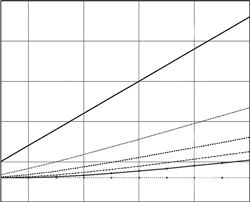Radio monitoring complex model as multi-phase queuing system
DOI:
https://doi.org/10.3103/S0735272722030050Keywords:
radio monitoring complex, queuing systemAbstract
In development of radio monitoring complex much attention is paid as a rule to possibility of greater amount of communication signals and data transmission protocols, and performance increase is achieved due to increase of processing channel amount. But signals and protocols processing is realized sequentially according to open system interaction OSI model. Processing of signals and protocols at each next layer begins only after ending of previous layer processing. It results in some functional hardware and software units of the complex are in processing mode whereas there other ones are in unoperable mode. The authors of this paper consider development the conditions of simultaneous operation of all complex units for processing of the signals and the protocols of different layers, increase of the complex operation efficiency and simultaneous decrease of processing channels resulting in decrease of the complex cost. In this paper there are determined three stages of the transformation of communication signals and data transmission protocols in radio monitoring complexes. A model of such complexes is represented in form of three-phase queuing system. The first phase is represented in form of queuing systems without queue, the second and the third phases are the systems with infinite queue. For each phase we represent the states graph, and formulas for definition of the states probabilities and the systems characteristics are given. Service probability and average time of service request stay in radio monitoring complex are compared analytically, and experimental dependences are built. It is proved that three-phase radio monitoring complex provides greater service probability than single-phase one in case of less amount of the service channels that results in reduction in cost of the complex in case of admissible increase of the service time. Specific values of the complex characteristics are calculated for selection of its optimal structure dependently on initial conditions by means of optimization problem solution. The order of selection of the radio monitoring complex rational structure is represented.
References
V. F. Erokhin, O. M. Romanov, S. N. Nikolaev, “Determining the effectiveness of signals detection during search,” in 2020 IEEE 2nd International Conference on Advanced Trends in Information Theory (ATIT), 2020, pp. 148–153, doi: https://doi.org/10.1109/ATIT50783.2020.9349311.
A. Rembovsky, A. Ashikhmin, V. Kozmin, S. Smolskiy, Radio Monitoring, vol. 43. Boston, MA: Springer US, 2009, doi: https://doi.org/10.1007/978-0-387-98100-0.
A. M. Rembovsky, A. V. Ashikhmin, V. A. Kozmin, S. M. Smolskiy, “Automated radio monitoring systems,” in Signals and Communication Technology, 2018, pp. 1–62.
I. M. Saschuk, O. M. Romanov, “Application of system approach for synthesis of hardware-software complexes of technical analysis of signals on basis of information-signature technologies,” in Systemnyi Analiz ta Informatsiyni Tekhnologii (SAIT), 2016, pp. 153–154.
B. A. Liakh, V. A. Kondratyonok, “Modelling of radio monitoring system of short-wave radio communication adaptive systems,” Syst. Anal. Appl. Inf. Sci., no. 2, pp. 50–53, 2015, uri: https://sapi.bntu.by/jour/article/view/58.
H. A. Taha, Operations Research: An Introduction. Pearson, 2017, uri: https://www.pearson.com/us/higher-education/program/Taha-Operations-Research-An-Introduction-10th-Edition/PGM334070.html.
E. S. Ventsel, L. A. Ovcharov, Applied Problems of Probabilities Theory, [in Russian]. Moscow: Radio i Svyaz’, 1983.
A. Asanjarani, Y. Nazarathy, P. Taylor, “A survey of parameter and state estimation in queues,” Queueing Syst., vol. 97, no. 1–2, pp. 39–80, 2021, doi: https://doi.org/10.1007/s11134-021-09688-w.
O. M. Romanov, “Model of radio monitoring station as queuing system,” in Systemy I Teknologii Zvyazku, Informatyzatsii ta Kibergbezpeky: Aktualni Pytannya, 2021, pp. 248–249.
A. T. Kozlovskiy, N. Y. Marmushev, M. M. Taraskin, “Analytical description of functioning of system of aggregation and processing of information of monitoring elements on basis of queuing system,” Vopr. Zaschity Informatsii, no. 4, pp. 67–72, 2017.
M. Zukerman, Introduction to Queueing Theory and Stochastic Teletraffic Models. 2013.
S. Hess, A. Grbčić, “The multiphase queuing system of the Rijeka airport,” Pomorstvo, vol. 33, no. 2, pp. 205–209, 2019, doi: https://doi.org/10.31217/p.33.2.10.
R. Khayrullin, A. Myasnikov, “Application of methods of the theory of multiphase queueing systems to the problems of optimizing the resources of service companies in the field of housing sector,” MATEC Web Conf., vol. 1964040, 2018, doi: https://doi.org/10.1051/matecconf/201819604040.
A. S. Ajiboye, K. A. Saminu, “A multi-stage queue approach to solving customer congestion problem in a restaurant,” Open J. Stat., vol. 08, no. 02, pp. 302–316, 2018, doi: https://doi.org/10.4236/ojs.2018.82019.
M. M. Alani, Guide to OSI and TCP/IP Models. Cham: Springer International Publishing, 2014, doi: https://doi.org/10.1007/978-3-319-05152-9.
H. Benker, Practical Use of Mathcad®. London: Springer London, 1999, doi: https://doi.org/10.1007/978-1-4471-0539-8.


